Sunday night I was on the sidelines shooting the NFL game between the Chiefs and Colts. By the time the game started, though, I was already halfway through my day’s work. Here’s what goes into covering a pro football photography assignment for a major wire service.
The Associated Press has a contract with the National Football League to provide images to them, in addition to distributing photos to their member organizations (newspapers, magazines, website, etc.). Which means they not only staff every game, but need to come away with a wide variety of photos from each one. As well as actual game coverage, they’ll want pictures of players that come out to the field before official warm-ups, the warm-ups themselves, other pre-game activities, team and TV personalities, fans, possible fashion statements (what players wear pre and post-game), post-game on-field activity and finally the end-of-game press conferences. It makes for a very, very long day. And of course there’s the prep work to be done before ever leaving for the stadium. Let’s start there.
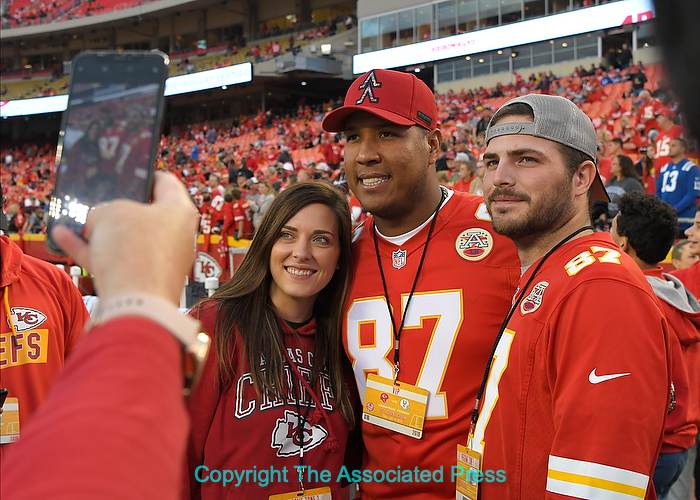
It’s not all about the action. When the Kansas City Royals’ All Star catcher, Salvador Perez came down to the field before the game, fans wanted photos of him. And I did too. Nikon D500, Aperture Priority, Auto white balance, ISO 1000, 1/640 at f/4.5 in Matrix metering, 0.0 EV, Nikkor Nikkor 24-70mm f/2.8 lens at 24mm.
To cover an assignment like this, here’s what I used:
- Nikon D5 and D500 cameras, lots of extra cards, readers and three fully charged batteries for each.
- Nikkor 200-400mm f/4 lens. This has become the pro’s go-to lens for football because of two things. One, having the zoom capability is great for action that may be coming at you or moving away. And two, f/4 is fast enough, even for night games, with today’s high ISO cameras. I use it paired with the D5 on a monopod.
- Nikkor 24-70mm f/2.8 VR lens, on my D500. This gives me an equivalent focal length of 36-105mm on the DX body, great for anything that might happen near me.
- Nikkor 70-200mm f/2.8 and 18-35mm f/3.5-4.5. These two lenses are for the end of the game and press conferences, though I might put the 18-35mm on before that if there’s a super-wide shot I need to make beforehand. But I carry them the entire game just in case.
- Laptop with Photo Mechanic (download, browse, select, caption) and Photoshop (edit) on it.
- Rain gear (not in the forecast, but better safe than sorry)
I rolled into the stadium with that kit at 3:30pm, almost four hours before game time. Despite that, I still had to park about a half-mile from the photographer’s entrance. People here in KC are serious about their tailgating, and being a Sunday night game they had all afternoon to party.
When I finally got to the photo room (about 50 yards off the field up a tunnel), I joined the rest of the AP staff gathering to discuss coverage. While there were just two of us actually shooting the game, we totaled six people. Two AP staffers would remain in the photo room the entire time, as editors, downloading, selecting, captioning, editing and transmitting photos (this is actually the hardest and most important job). Two volunteers were also there as “runners.” Their job was to stay behind the two of us shooting, and run the cards from our cameras to the editors every 10-15 minutes during the game.
The actual photography started around 4:30pm, as some players always come onto the field early. That lets us make some photos – hopefully of key players – in casual workout clothes. By 5:30pm we’ve turned in those photos and taken a short break to eat dinner. Then we return to the field, shortly after 6pm. Both teams come out an hour before the game, in full uniform, for warm-ups. That lasts about thirty minutes, then they go inside for final team meetings before the pre-game introductions. Of course, we’re making pictures of anything we can from those warm-ups through introductions, as that lets the editors get a jump on transmitting some early photos. Kick-off, of course, is when life really gets interesting.
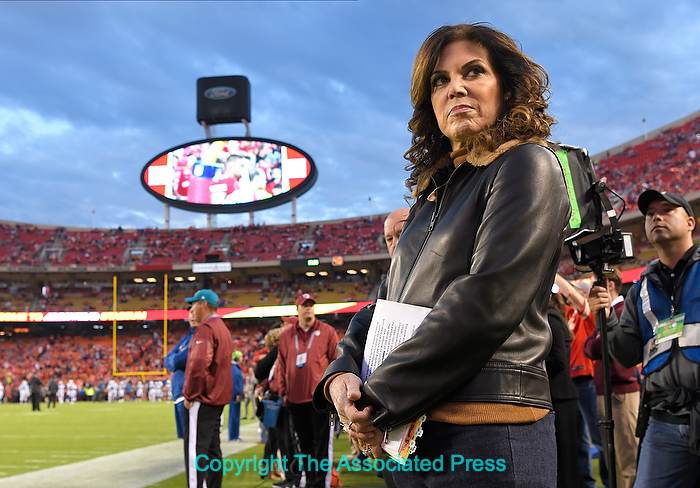
Michelle Lafoya is a sideline reporter for NBC, who was broadcasting the game. And that made her someone I needed to make pictures of. Nikon D500, Aperture Priority, Preset white balance, ISO 1000, 1/400 at f/4 in Matrix metering, 0.0 EV, Nikkor Nikkor 24-70mm f/2.8 lens at 24mm.
Since there are just two of us shooting the game for AP, we have to make sure we get photos of every important play. That means we cover it as a team, with specific responsibilities. We’re on opposite sidelines, and on opposite sides of the line of scrimmage as well. Photographers are only allowed in the end zones and the sidelines up to the 30-yard-line (we can cross behind the benches, but can’t stop or shoot photos there). We’re also behind just about everyone else who has the right to be on the sidelines (officials, ball boys, TV people, team hangers-on…). Because of those two things, we’re rarely in the same position for more than one play. It’s shoot and move, shoot and move. Over the course of a game I’ll walk more than five miles. Not surprisingly, my runner will cover even more ground.
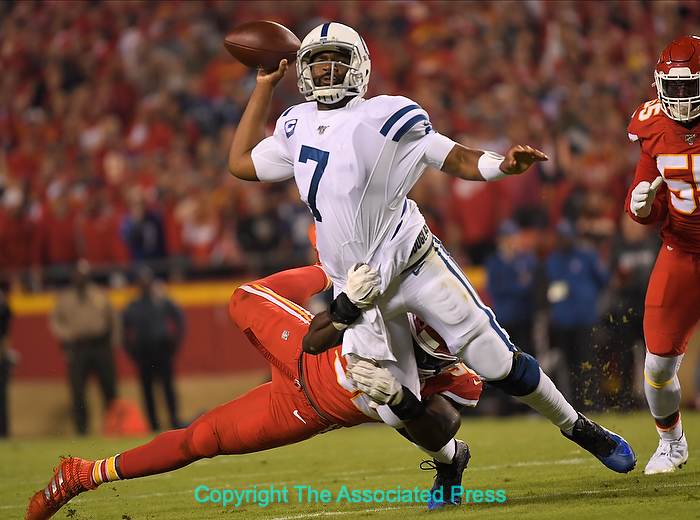
Any action of a quarterback running, throwing or being pressured, when you can see their face, is good to have. Here the Colts’ Jacoby Brissett gets a pass off while under tackle. Nikon D5, Manual exposure, Preset white balance, ISO 2500, 1/1250 at f/4 in Matrix metering, Nikkor 200-400mm f/4G lens at 400mm.
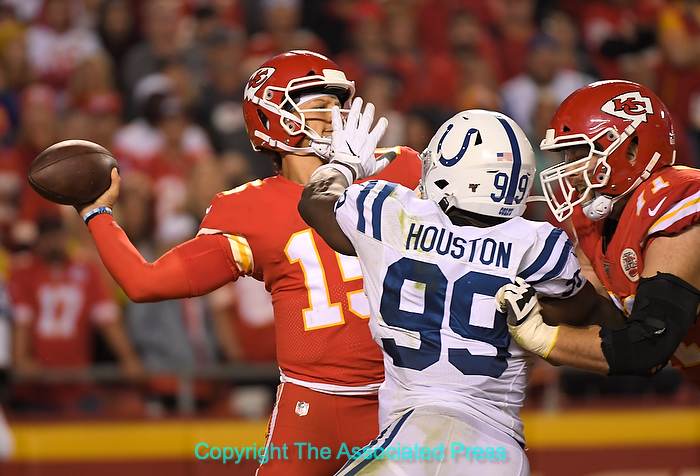
Again, quarterback passing, under pressure, face partially visible. And 99, Justin Houston, would play a huge role in the Colts’ victory. Nikon D5, Manual, Preset white balance, ISO 2500, 1/1250 at f/4 in Matrix metering, Nikkor 200-400mm f/4G lens at 400mm.
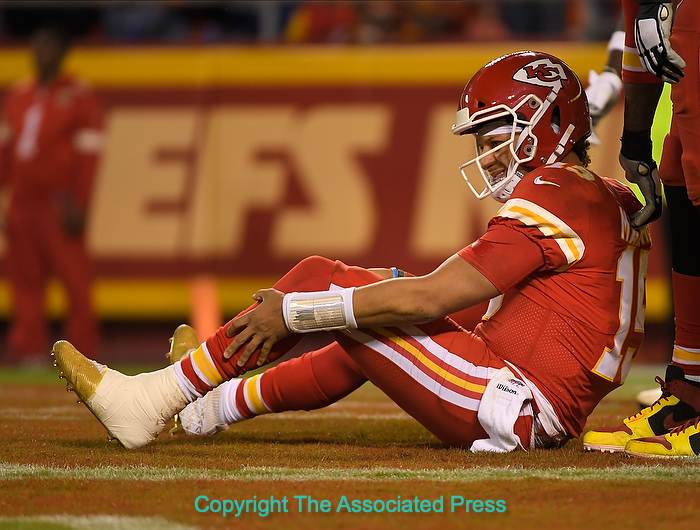
When the Kansas City Chiefs’ MVP quarterback goes down, grabs his leg and winces, that’s a picture you have to make. Patrick Mahomes is playing with an injured ankle and had it stepped on by a teammate during this play. Nikon D5, Manual exposure, Preset white balance, ISO 2500, 1/1600 at f/4 in Matrix metering, 0.0 EV, Nikkor 200-400mm f/4G lens at 400mm.
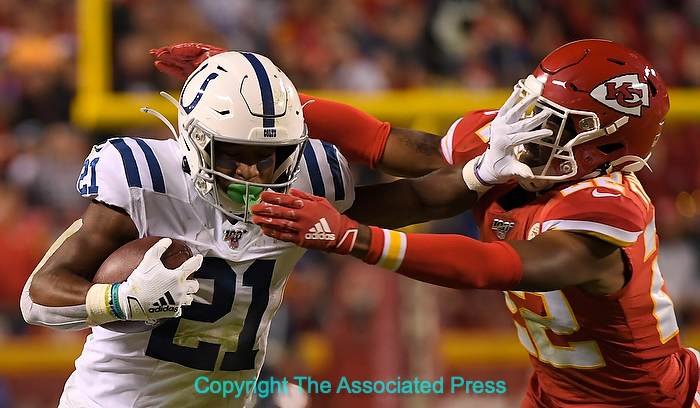
The ability to zoom out as action comes at you is what makes the 200-400mm lens so valuable. Nikon D5, Manual exposure, Preset white balance, ISO 2500, 1/1250 at f/4 in Matrix metering, Nikkor 200-400mm f/4G lens at 310mm.
As for getting pictures out, gone are the days of newspaper deadlines determining how soon we need to send pictures. Today it’s all about getting photos out as soon as possible, and constantly. So those two runners are pretty much constantly on the move. We have to get photos out ASAP of each quarterback in action during their first series of downs. Quarterback photos, of course, are high priorities, as are any player who has a big game, touchdowns, interceptions, fumbles, injuries, coaches – anything that’s important to the story of the contest. And that’s also why there are two editors in the photo room. It takes two to be constantly sending that many photos.
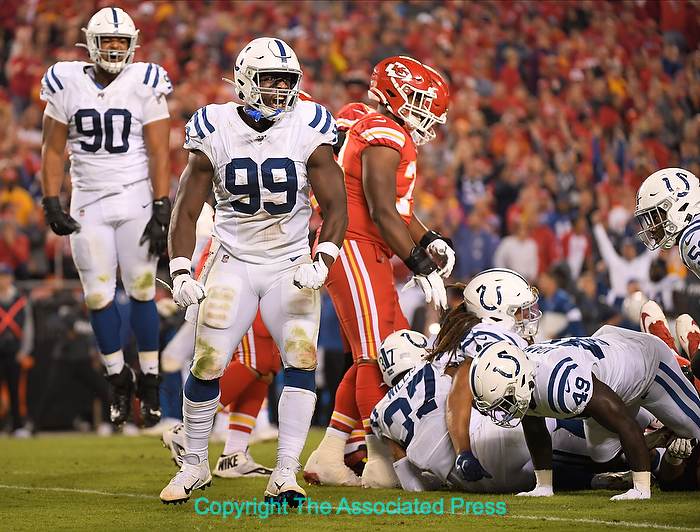
This was, by many accounts, the play of the game. The Chiefs, trailing, went for it on fourth and one late in the game, and Justin Houston, #99, stopped the play behind the line of scrimmage. I have the tackle too, but the reaction is better. He was a Chief until this season, when the Colts acquired him. Nikon D5, Manual exposure, Preset white balance, ISO 2500, 1/1250 at f/4 in Matrix metering, 0.0 EV, 200-400mm f/4G lens at 240mm.
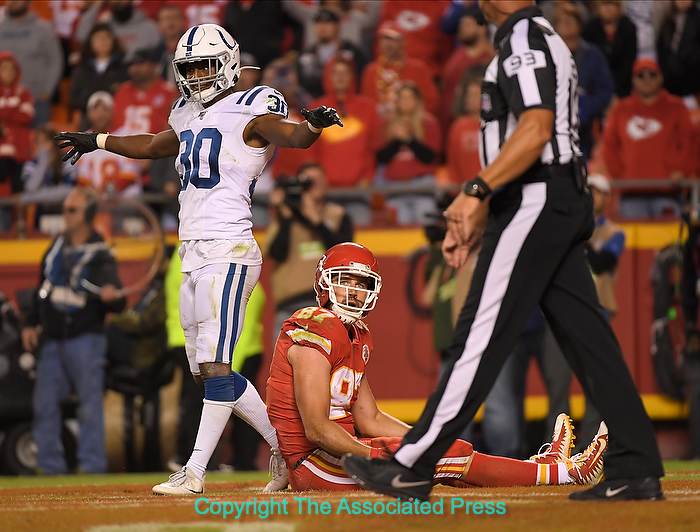
Again, the reaction is more important than the action. This shows the Chiefs’ Travis Kelce reacting in disbelief after being unable to make a catch in the end zone near the end of the game, with the Chiefs trailing. Nikon D5, Manual, exposure, Preset white balance, ISO 2500, 1/1250 at f/4 in Matrix metering, Nikkor 200-400mm f/4G lens at 350mm.
When time runs out in the fourth quarter, we’re still not done. At that point we hand off our long lens to the runner and literally run onto the field to cover the teams and coaches gathering afterwards. That’s a mad-house, and the key is to use a wide lens and shoot a lot. That’s also one of the few times I shoot with the camera away from my eye. Often I’m holding it over another photographer or TV cameraman, or squeezing it into the gap between two of their heads.
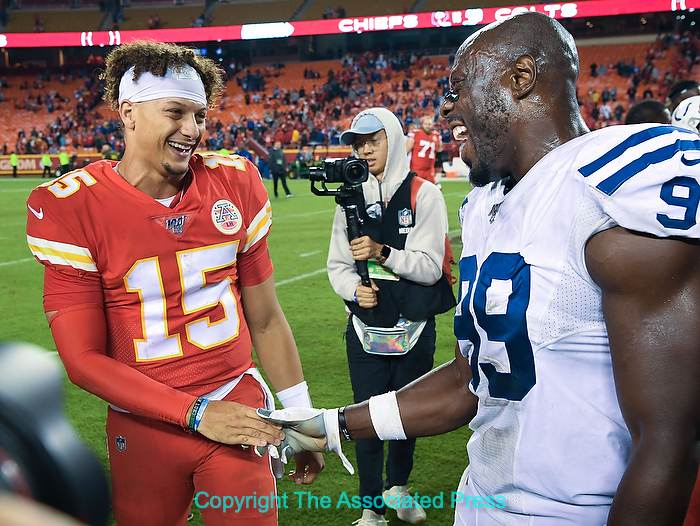
Justin Houston, right, made life hard on Patrick Mahomes and the Chiefs all night, but after the game the two friends, who played together for the Chiefs until this season, greeted each other on the field. Nikon D5, Manual, exposure, Preset white balance, ISO 2500, 1/800 at f/5 in Matrix metering, Nikkor 24-70mm f/2.8 lens at 29mm.
As the after-game action on the field cools, it’s time to head inside for the press conferences. There are rooms set up for that, and the head coach always speaks, then the quarterback and occasionally another player who’s had an exceptional game. After that, finally, it’s time to stop. We head back to the photo room, check in with the editors, and start packing our gear. By the time I return home, it’s early Monday morning and I’ve been gone 9.5 hours.
I started shooting NFL games with the Buffalo Bills while working in upstate New York in 1980. And I’ve now been covering the Kansas City Chiefs since 2000. It’s an assignment I find challenging in about every way. Challenging in capturing peak action and moments, challenging in the varying conditions we have to work in and challenging physically. But that challenge also makes it fun, and with any luck, I’ll be doing it for many more years.
– If you want to see everything I shot that the editors posted, click this link –
(If you like this story, please share it with your friends and let them know about the links on photography that I post on my business Facebook page. I’m also on Instagram and Twitter, @reedhoffmann. And if you’re curious about the workshops I teach, you can find them here.)

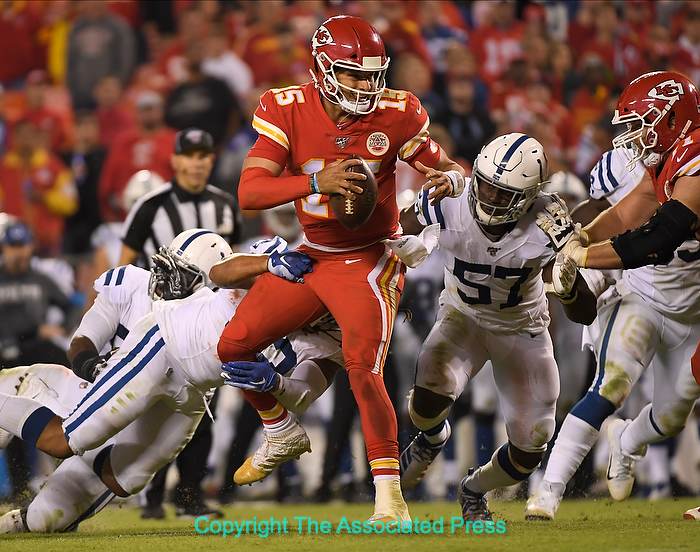
Thanks, John, glad you enjoyed it.
What a fascinating read. Thanks for sharing Reed.
Thank you so much for this story I found this very interesting. As a local sports photographer and just big sports fan this is all our dream to get down close and shoot away the best in the world. Again Thanks for taking the time and giving us a little insite into this unseen world of those who give us these amazing photos.
Glad you enjoyed it, Steve.
Reed, great story and background on shooting NFL. Recently I’ve tried my hand at shooting high school football. Obviously, the lighting at a night HS game is nowhere near what it is for the NFL. I used a 200-500 f/5.6 but could only use it up to dusk. Once night hit, I used the 70-200 2.8 but still had to shoot an ISO of around 3500 to freeze action. (1/640). The lighting is so poor that at f/4 I could not get my shutter speed fast enough to freeze. Fortunately I had the D500 and the D850 which could handle the high ISO. As an experiment I used my 85 1.8 and got good results when the action was closer. When shooting at a game do you shoot using Matrix or spot metering? I used Matrix but now wondering if spot would have been better. Thanks Reed
Hi Rob. For night or indoor sports, where the lighting doesn’t change (much), I simply work in Manual exposure. Even if the end zones are a bit darker, I just drop shutter speed some when the action gets there. When I started shooting sports, we were using 1/250 shutter speed. Maybe 1 in 10 were usable 🙂
Great story Reed & terrific photos! WOW!
…quick technical questions: 1. when you do the games do you still shoot RAW? or does the AP want JPEGs so they can get the images out as fast as possible? And 2, how in the world do you carry all that gear with you without toppling over? …
…Again, thanks for posting!
Hi Norm. You’ll find that very, very few news or sports photographers shoot RAW simply because of the added time involved in processing the images. That’s why those photographers tend to be very good with while balance and exposure (I have Preset white balance settings saved for the pro sports venues here because of that). As for the gear, the D5 and 200-400 are on a monopod, and i carry them over my shoulder when moving, and the D500 with 24-70 is on a cross-chest strap. Rest of gear is in a waistbelt. And if feels so, so good to take it all off after the game! 🙂
As always Reed you are a master and above all a gentleman. Thanks for the insight.